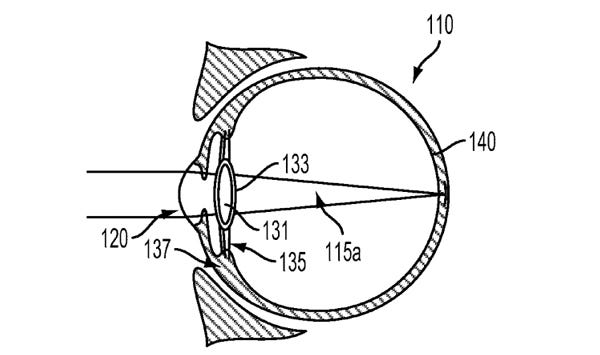May 6, 2016
Its device would free people over 40 from bifocals and replace lenses damaged by cataracts.
Nancy Crotti
|
Google's patent application describes a lens that "can be installed within a flexible polymeric material shaped to conform to the inside surface of a lens capsule of an eye." (Image from Google's patent application) |
Google has its eyes on an smart lens that can be implanted in the eye and might improve wearers' vision.
An application for the device filed in 2014 with the U.S. Patent and Trademark Office was made public this week. It describes a lens that "can be installed within a flexible polymeric material shaped to conform to the inside surface of a lens capsule of an eye." The work of eye muscles to improve focus, known as "accommodation," would change the optical power of the device, according to the application. An accommodation sensor within the device could sense the eye's focusing efforts and control that power.
The device could help wearers with a variety of conditions that result in decreased accommodation, focus, or "other degradation of images presented to the retina," the application says. Presbyopia is one. It affects adults as they age and leads them needing bifocals, reading glasses, or contact lenses. Cataracts, which surgeons often remove, could be replaced by one of these lenses, it adds.
The application posits a few ways the device could work. For instance, the electronic lens could include piezo elements, electro-wetting elements, liquid crystal elements and/or reservoirs, microfluidic elements and/or reservoirs, or other electronic actuators configured to change the shape, thickness, or curvature) of the electronic lens based on an electric signal applied to it.
The device could also include one or more other lenses to work with the electronic lens. It could also hold one or more antennas to let the device communicate with and/or receive wireless power from an wearable, external system, such as eyeglasses, the application states.
Google did not immediately respond to a request to discuss the application. Google's sister Verily health tech company has been working with Novartis' Alcon eye care division to commercialize a smart contact lens, but it's not clear whether this is the same device. That technology has also been touted as a way to allow diabetics to one day monitor their blood glucose without finger pricks.
Jeffrey Sonsino, chair-elect of the contact lens and cornea sector of the American Optometric Association, said the technology described in the patent application sounds similar to the Google-Novartis smart lens.
"If they're able to produce this, it will be a revolutionary idea in eyecare," said Sonsino, the holder of nine patents. "This technology will help people over the age of 40 to be able to read without reading glasses or contact lenses."
The optometry association would be most concerned with patient safety, given that the smart lens would have to be surgically implanted. Whether it would pose a threat to the practice of optometry and the eyewear business is another story. Sonsino likened it to LASIK, a laser-surgery procedure that reshapes the inner cornea to correct vision.
"LASIK has done some wonderful things for the profession, and it's done very bad things for it," he said.
Learn more about cutting-edge medical devices at MD&M East, June 14-15, 2016 in New York City. |
Nancy Crotti is a contributor to Qmed and MPMN.
Like what you're reading? Subscribe to our daily e-newsletter.
About the Author(s)
You May Also Like



